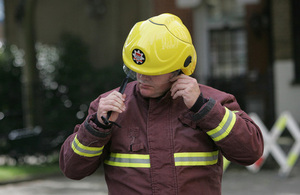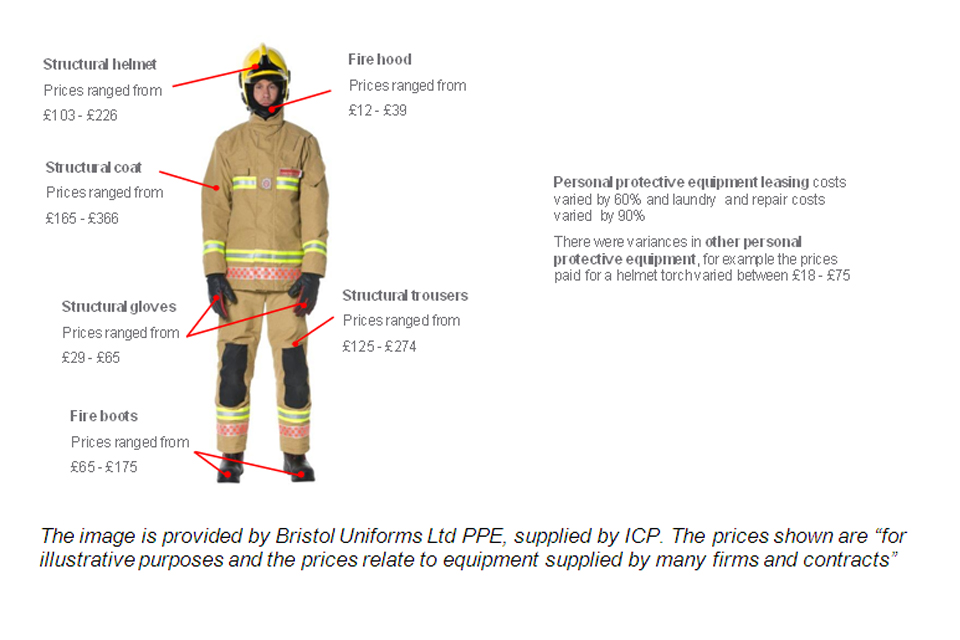Fire service could save millions by improving how it buys kit
The fire and rescue service could save millions by improving the way it sources and purchases firefighting clothing and equipment.

The fire and rescue service could save millions in taxpayer cash by improving the way it sources and purchases firefighting clothing and equipment says new research published by Fire Minister Brandon Lewis today (13 March 2014).
The findings highlight examples of fire services buying identical kit at vastly different prices. The report found that across the country the 46 fire and rescue services could save millions by streamlining this process and standardising how they buy clothing and equipment. Key differences include:
- prices for the same kit can vary by as much as 200% - a pair of protective trousers cost between £125 and £274
- when the same supplier was used prices varied by a quarter: for example a fire helmet can cost between £105 and £131
- even when the same contract was used there is still a significant price range of 66% - a fire coat can cost between £220 and £366.
The report concludes that fire and rescue authorities could achieve savings of £18 million from a total spend of £127 million a year. The savings could be even greater if applied to all purchases by all fire services, which spends an estimated £600 million each year on buying equipment and fire engines.
Today’s findings follow last year’s report by former chief firefighter Sir Ken Knight, which highlighted the scope for the services to find £200 million in savings whilst safeguarding emergency operations and protecting public safety.
It revealed huge variations exist between how the 46 different fire authorities operate, with the cost per head of providing a service almost double in some areas to that of others. The government will publish its response shortly.
Brandon Lewis said:
It cannot be right that the price of the same piece of kit or protective clothing varies so much for different fire services. This report shows clearly that the 46 fire and rescue services must come together to maximise the buying power of the £600 million they spend and get the best possible value for money for taxpayers.
In the last decade there has been a 46% reduction in call outs and incidents, and accidental deaths from fires in the home have reached an all-time low yet expenditure and firefighter numbers have remained broadly the same.
The case for change is compelling. Taxpayers are right to expect the most cost effective purchases and fire and rescue authorities must seize this opportunity to make changes to drive better procurement.
Fire and rescue procurement aggregation and collaboration, was a joint research project with Chief Fire Officers Association. It recommends that fire and rescue authorities seize the opportunity to deliver these significant potential savings by:
- agreeing a common classification of goods and services for 46 fire and rescue authorities
- producing an index of prices paid on kit to avoid paying more for the same product
- securing internal sponsorship, and partnership arrangements
- managing supplier relationship and contracts better
- developing a strategy for buying common non-fire goods and services together such as energy to office supplies
- developing a national procurement pipeline plan that documents existing contract periods, future tendering exercises and large-scale procurement opportunities
The following figure illustrates the different range of prices for personal protective equipment and the scale of savings on offer.

Further information
The research was funded by the Department for Communities and Local Government and jointly commissioned with the Chief Fire Officers Association, through PA Consulting to identify how fire and rescue authorities currently procure, where there are opportunities to buy more efficiently and a range of strategic options on how these may be taken forward.
The report determined that it is likely that, standardisation or products will deliver even greater savings and with the greater volumes through collective procurement, this could add to the wider economies of scale. For example if more fire and rescue authorities bought the same vehicles then they would not only save on the vehicles themselves, but also on the parts, maintenance and training.
Collaboration means the same procurement is not repeated time and time again in different services – saving time as well as money. All of these findings make the case for collaborative procurement stronger than ever. It sets out the strategic plans for fire and rescue authorities to deliver new, meaningful and sustainable savings.
Knight Review – Facing the Future
On 17 May 2013 Sir Ken Knight published his independent review Facing the future: findings from the review of efficiencies and operation in fire and rescue operations in England identifying ways in which fire and rescue authorities could make savings and improvements without compromising the quality of vital fire prevention and other frontline services. ‘Facing the future’ identified the potential for savings of almost £200 million.
Sir Ken identified that the 46 fire and rescue authorities across England each had their own management structures, senior leaders and operational differences. Between 2008 to 2012 total reserves held by stand-alone fire and rescue authorities increased from just over £200 million to more than £400 million. This highlights the potential for investing in spend-to-save type projects.
The government has set up a £75 million Fire Transformation Fund to encourage closer co-operation.
Office address and general enquiries
2 Marsham Street
London
SW1P 4DF
Email correspondence@communities.gov.uk
General enquiries: please use this number if you are a member of the public 030 3444 0000
If your enquiry is related to COVID-19 please check our guidance page first before you contact us - https://www.gov.uk/guidance/coronavirus-covid-19-guidance-for-local-government.
If you still need to contact us please use the contact form above to get in touch, because of coronavirus (COVID-19). If you send it by post it will not receive a reply within normal timescale.
Media enquiries
Email newsdesk@communities.gov.uk
Please use this number if you are a journalist wishing to speak to Press Office 0303 444 1209